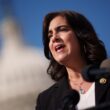The green economy may be the best chance in a generation to create far more well-paying career opportunities for New Yorkers of color and those from low-income communities — many of whom have long borne the brunt of environmental injustices.
With hundreds of thousands of green jobs expected over the next 15 years, private and public sector leaders in New York have taken smart steps to build a constellation of green economy workforce training programs, ensuring that a broad swath of New Yorkers are prepared for these jobs.
But New York will never fully realize this tantalizing opportunity if the jobs don’t materialize.
Unfortunately, that’s a legitimate concern. A new report by the Center for an Urban Future finds that growth in New York City’s green economy has been slower than many anticipated, with relatively little hiring in recent years. While postings for jobs requiring green skills have been rising, the core green economy remains small. In 2023, there were just 2,184 unique job postings in the city’s core green economy — far fewer than traditional industries like health care (70,002), finance (56,314), and tech (46,912).
At the same time, where there has been growth in green jobs in New York, much of it has been in industries outside of the core green economy. For example, from 2013 to 2023, the number of annual job postings for positions seeking green skills increased by 314 in the architecture and engineering sector, by 354 in finance, and by 491 in the colleges and universities sector.
Many of these roles typically go to candidates with college degrees and aren’t readily accessible through the short-term training programs that have been expanding across New York.
To unlock the green economy’s vast potential, city leaders will need to address the many obstacles that are dampening job creation here. What’s needed most right now isn’t a slate of shiny new policies and programs, but a full court press to ensure New York effectively implements key initiatives already underway — starting with the landmark Local Law 97.
Enacted in 2019, Local Law 97 mandates emissions-reduction investments across the city’s buildings sector that, when implemented, will likely spark more new job creation than any other part of the green economy. But progress has been slow as building owners grapple with high borrowing costs, long payback periods, technical and logistical challenges, and a regulatory scheme in which the cost of compliance significantly outweighs the penalties.
As one sign of the modest pace of progress, just 2,021 permits to install new heating and cooling systems have been filed since 2017. Similarly, while there has been a notable increase in the installation of heat pumps, fewer than 1% of all housing units statewide have one.
City leaders can strengthen and expand efforts to ensure Local Law 97 succeeds by swiftly deploying an NYC Green Building Fund — a revolving loan fund that will provide flexible, low-interest loans to buildings to finance decarbonization projects.
They should also expand the innovative but small-scale PACE Financing program, which helps connect eligible buildings to lenders who can help finance retrofit projects, and launch a Green Building Assistance Corps to bolster the effectiveness of NYC Accelerator, which provides personalized guidance to help building owners navigate Local Law 97.
Given that many of the jobs growing in New York’s green economy are going to individuals with at least a bachelor’s degree, city leaders should also better leverage the City University of New York (CUNY). One way to do so is by launching a major new capital investment to build a greener CUNY, paired with a first-of-its-kind initiative to tap CUNY’s students to achieve this — preparing them for green economy careers in everything from architecture, engineering, and materials science, to finance and capital planning, to the building trades.
Together these actions will help New York not only reap the green economy’s vast potential for sustained job growth for years to come, but also realize the sector’s enormous promise to launch tens of thousands of low-income New Yorkers into well-paying careers.
Bowles is the executive director of the Center for an Urban Future and Dvorkin is the center’s editorial and policy director.








